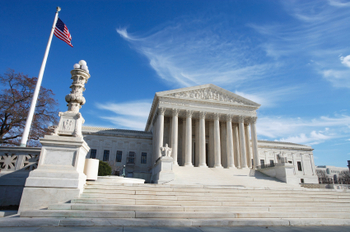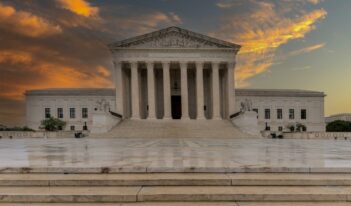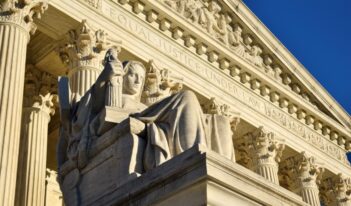
The Court should allow the political process to resolve recess appointments controversy.
After more than a year of political and legal wrangling, the Senate arrived at the “consent” part of its “advice and consent” power in July when it finally confirmed five nominees to the National Labor Relations Board (NLRB). This action demonstrates that all is not lost, even at a moment of widely diagnosed congressional dysfunction. The mix of incentives and disincentives created by the Constitution’s allocation of overlapping powers to the two elected branches – even colored by party competition within Congress and the rules of each House – can sometimes accomplish what the framers intended, namely, to discourage overreach and abuse.
The Senate’s action now enables the Supreme Court in its upcoming term to avoid altering the Constitution’s separation of power dynamics. In its review of the D.C. Circuit Court’s decision in Noel Canning v. NLRB, a dispute over intrasession recess appointments spawned by the prolonged NRLB imbroglio, the Supreme Court should avoid making any constitutional rules, instead vacating and remanding the lower court’s decision.
In Noel Canning, the D.C. Circuit invalidated President Obama’s January 2012 invocation of his recess appointments power to name three members to the NLRB. Although over 300 federal officials since 1981 have received such appointments during congressional sessions, the panel unanimously concluded that the recess appointments power was available only between sessions of Congress. Two of the three judges went further. They interpreted the recess appointments power as applying only to offices that first become vacant between sessions of Congress. That holding would likely invalidate most of the more than 300 additional recess appointments that presidents since Reagan have made between congressional sessions.
Since that decision, two other courts of appeals have also invalidated recess appointments – and the Supreme Court has agreed to hear Noel Canning. Although I am strongly of the view that the D.C. Circuit was wrong, the Supreme Court should eschew the opportunity to say so.
Although the recent lower court opinions emphasize the intended role of recess appointments as auxiliary to the preferred path of nomination and advice and consent, it is clear that the framers intended the President to take the leading role in staffing the executive branch. The Senate was given a role in the appointments process not to impede the President’s policy agenda, but to check potential corruption. Protecting the Senate’s confirmation role at the expense of the President’s appointments responsibility turns the constitutional design on its head.
If the President’s position were to be rejected by the Supreme Court, then presidents – who are constitutionally charged to “take Care that the Laws be faithfully executed” – could be permanently stymied in the execution of their administrative responsibilities by a determined Senate minority. Executive administration could even be blocked by members of the House of Representatives intent on disabling a Senate majority from adjourning, as actually occurred in 2011. Yet there is certainly no plausible argument that the House is intended to have a role in the appointments process.
The D.C. Circuit’s originalist reading of the relevant Article II text is wrong on its own terms. But even if the founding generation anticipated that the word “recess” would mean only periods of intersession adjournment, it makes no sense to operationalize the Framers’ language in 2013 in a way that would defeat their basic design. Clauses of the Constitution should be read to give effect to as much of the principled constitutional design as possible.
Judge Greenaway makes this point forcefully in his persuasive dissent in the Third Circuit’s recess appointments case. “The Recess Appointments Clause,” he urges, “cannot be fully understood in isolation but only within the fabric and spirit of the Constitution as a whole.” Judge Greenaway urges that the appointment power “must be coordinated so that no branch can ‘possess, directly or indirectly, an overruling influence over the others.’” Yet, “overruling” is just what the Senate’s obstructionism has amounted to, and obstructionism is exactly what the D.C. Circuit’s Noel Canning opinion effectively licenses.
If the Supreme Court reaches the merits, I suspect a majority would agree with my reading of the original text and my understanding of the practical consequences of the Noel Canning holding. But the Court should not address the issue at all.
The Solicitor General should ask the Court to remand the Noel Canning dispute for rehearing by the newly re-constituted NLRB. If it did so, the Supreme Court should grant the request but maintain its own jurisdiction over the case to police the adequacy of that rehearing. Upon re-acquiring the administrative record, the NLRB would have to “re-hear” the case, but it would not have to start from scratch. It could propose to the parties that the Board take what the statute calls “official notice” of the entire earlier record and decide the case on the basis of that record, unless the parties wish to contribute something new. The Justice Department should then ask the Third and Fourth Circuits to vacate their opinions as well, subject to the same rehearing opportunity before the NLRB. The Board could likewise offer to make the identical procedure available to any party whose case was decided between 2010 and 2013 by intrasession-recess-appointed Board members, effectively precluding further constitutional controversy.
Alternatively, the Supreme Court could decide on its own that the interpretation of which periods of adjournment c
ount as recesses for purposes of the recess appointments clause presents a “political question” for the elected branches to sort out by themselves. This would follow the Court’s plurality approach in Goldwater v. Carter, in which the Court refused to say whether the Constitution required presidents to get any form of congressional consent to withdraw the United States from a treaty that the Senate had ratified. Concurring with the plurality, Justice Powell wrote, “Differences between the President and the Congress . . . should, and almost invariably do, turn on political rather than legal considerations.” He urged the Court to avoid determining the proper allocation of power until the branches reach a true “constitutional impasse.”
Treaty termination disputes and the recess appointments disputes resemble each other in two critical respects. First, unlike other separation of powers disputes that the Court has resolved – in cases such as Youngstown Steel, Chadha, or Boumediene – Noel Canning does not relate to individual rights or liberties. There is no reason to think that a party before the NLRB has received a hearing that is any less fair, robust, or respectful of the law because a member of the Board was appointed during a Senate session, as opposed to between Senate sessions. Life, liberty and property are simply not at issue.
Second, in both treaty termination and recess appointment cases, the Court must confront “a dispute between coequal branches of our Government, each of which has resources available to protect and assert its interests, resources not available to private litigants.” Where the Constitution assigns to the elected branches a shared power, as with treaties or appointments, the Court behaves wisely in allowing each branch’s political and institutional incentives and disincentives to operate, as they were intended, to curb overreach by the other branch.
The Senate, this past July, saw the wisdom of stepping back from the brink of crisis and allowing normal, albeit sometimes messy, governance to proceed. The Supreme Court can best reaffirm that spirit by exhibiting its own restraint and leaving to the members of the elected branches the capacity and responsibility to work out the recess appointments power on their own.




